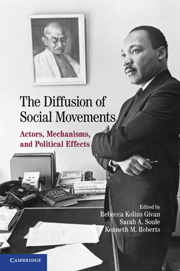Book contents
- Frontmatter
- Contents
- List of Tables
- List of Figures
- Contributors
- Preface and Acknowledgments
- 1 Introduction: The Dimensions of Diffusion
- PART I DIFFUSION AND THE FRAMING OF CONTENTIOUS POLITICS
- PART II MECHANISMS OF DIFFUSION
- 6 Dialogue Matters: Beyond the Transmission Model of Transnational Diffusion between Social Movements
- 7 The Diffusion of Different Types of Internet Activism: Suggestive Patterns in Website Adoption of Innovations
- 8 Transnational Networks, Diffusion Dynamics, and Electoral Change in the Postcommunist World
- 9 Diffusing the Rumor Bomb: “John Kerry Is French” (i.e., Haughty, Foppish, Elitist, Socialist, Cowardly, and Gay)
- PART III DIFFUSION, SCALE SHIFT, AND ORGANIZATIONAL CHANGE
- General Bibliography
- Index
9 - Diffusing the Rumor Bomb: “John Kerry Is French” (i.e., Haughty, Foppish, Elitist, Socialist, Cowardly, and Gay)
Published online by Cambridge University Press: 05 June 2012
- Frontmatter
- Contents
- List of Tables
- List of Figures
- Contributors
- Preface and Acknowledgments
- 1 Introduction: The Dimensions of Diffusion
- PART I DIFFUSION AND THE FRAMING OF CONTENTIOUS POLITICS
- PART II MECHANISMS OF DIFFUSION
- 6 Dialogue Matters: Beyond the Transmission Model of Transnational Diffusion between Social Movements
- 7 The Diffusion of Different Types of Internet Activism: Suggestive Patterns in Website Adoption of Innovations
- 8 Transnational Networks, Diffusion Dynamics, and Electoral Change in the Postcommunist World
- 9 Diffusing the Rumor Bomb: “John Kerry Is French” (i.e., Haughty, Foppish, Elitist, Socialist, Cowardly, and Gay)
- PART III DIFFUSION, SCALE SHIFT, AND ORGANIZATIONAL CHANGE
- General Bibliography
- Index
Summary
Scholars of contentious politics and social movements in sociology and political science (Tarrow 1998a) have used the concept of diffusion to help theorize the spread of a social movement and its claims for change. However, with few exceptions, they have not had much dialogue with communication studies of similar scholarly objects. Recently, scholars such as Ayres (1999) have developed the concept of social movement diffusion with regard to the Internet, although the set of references is limited almost entirely to sociology and political science. Ongoing interdisciplinary work is needed to understand the dynamics of diffusion in a highly complex, ever-changing culture of media convergence. Groundbreaking studies that focused on social movements and “mass media” in the past (Singer 1970) are outdated models for understanding a context in which journalism practices, news business values and markets, and media consumption have seen dramatic changes in the past twenty years, thanks to the arrival of cable, satellite, Internet, cell phones, infotainment, globalization of media businesses, narrowcasting, and downsizing resources in the news business (Harsin 2006). An interdisciplinary conversation may stand to enrich the conceptual development of diffusion.
This chapter builds on the interdisciplinary concept of framing in diffusion processes by bringing recent scholarship and concepts in media studies and political communication into conversation with work on social movements and contentious politics. More specifically, this article will use Henry Jenkins' (2006) concept of “convergence culture” to launch a discussion about the ways that ideas, issues, and beliefs are diffused or circulated in contemporary, highly electronically mediated, cultures.
- Type
- Chapter
- Information
- The Diffusion of Social MovementsActors, Mechanisms, and Political Effects, pp. 163 - 184Publisher: Cambridge University PressPrint publication year: 2010
- 1
- Cited by

